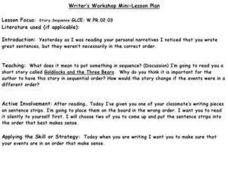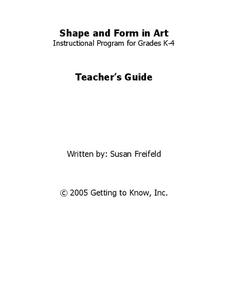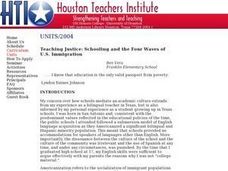Curated OER
Writers Workshop Story Sequence
Students read stories and explore the importance of sequential order. In groups, students are given sentence strips. Students holding the sentence strips, place themselves in a logical order to make a story. Individually, students...
Curated OER
Patterns and Sequences
Sixth graders explore pattern recognition and sequencing. They create arithmetic and geometric sequences with colors, shapes, and numbers. Students write expressions of arithmetic sequences and geometric sequences to find the nth term.
Curated OER
Two-Digit Numbers: 10 More or 10 Less
Complete the sequence by adding or subtracting 10! Although the instructions are slightly vague, the idea is that learners are given a starting number and fill in four sequential numbers by either adding or subtracting 10. The first four...
Curated OER
Fraction and Decimal Ordering
Ordering numbers just got physical! Learners practice putting numbers in sequence, both in fraction and decimal form. To begin, they line up in birthday order and discuss the difference between ascending and descending. They are then...
Curated OER
Exploration Sequence of Bounces
New skills are developed as students use graphing calculators and ranger technology to capture and graph the sequence of bounces a ball makes when dropped. After recording the height of four or more bounces, they use the collected data...
Math Salamanders Ltd.
Counting on by Digits Sheet 2
In this number sequence activity, learners fill in 40 missing numbers in sequence on 10 different number lines. Students calculate each single-digit step up for each one.
Curated OER
Story Elements - Sequence and Meaning
Students practice sequencing story elements for meaning. In this story elements lesson, students participate in a teacher demonstration in how to sequence story elements in a story about the grocery store. They break into groups by...
Inside Mathematics
Conference Tables
Pupils analyze a pattern of conference tables to determine the number of tables needed and the number of people that can be seated for a given size. Individuals develop general formulas for the two growing number patterns and...
Getting to Know
Shape and Form in Art
Introduce youngsters to the important role shape and form play in art with this extensive collection of activities and projects. From teaching first graders how to create mandalas to engaging third and fourth graders in the design...
Curated OER
Patterns Here, There, and Everywhere!
Upper graders access the Microsoft Word program and create patterns by utilizing certain keys on the keyboard. They create picket fences, smiley faces, and hearts. It seems that this instructional activity has as much to do with...
Curated OER
Toothpick Triangles
Explore patterns, variables, and mathematical relationships when you examine patterns with toothpicks and determine the next sequence of figures. Your class writes and justifies a formula based on the sequence. An answer key is included.
Curated OER
Phonics Instructional Routine: Read and Write Words with Consonant Digraphs
Use consonant digraphs to introduce learners to word patterns and high frequency words. They observe a chart with the digraphs /sh/, /ch/, /th/, and /wh/. After listening to each of these phonemes, scholars watch as the teacher...
Curated OER
Missing Number Game
Math partners help each other with number sequences in this interactive game. Young scholars arrange number cards in order, and Partner A closes his eyes. Partner B removes one card, after which Partner A must determine which card has...
Curated OER
Teaching Justice: Schooling and the Four Waves of U.S. Immigration
U.S. immigration is the focus of a unit on social justice. Over the course of a school year, young historians read a variety of texts to learn about four waves of immigration that have occurred over time in the U.S. An emphasis on...
Curated OER
Red Dirt Groundbreakers
Discover Oklahoma's first farmers. Read about 14 different agriculture workers and their contribution to Oklahoma's farming. After reading, have your class complete several activities such as researching an agriculturist, writing a...
Curated OER
Dear Diary
Work on narrative writing with this lesson, in which middle schoolers analyze the characters from a selected piece of literature and write narrative diary pieces as the character. They work to understand the point of view of the...
Curated OER
Recognizing Patterns
Middle schoolers explore the concept of patterns. In this patterns lesson, students use applets to manipulate tessellations. Middle schoolers predict the next number in a sequence by recognizing patterns.
Curated OER
Patterns
For this patterning worksheet, 1st graders write the patterns in terms of A and B and in terms of 1 and 2. They see a pattern of birds and cats, and stars and rectangles.
Curated OER
Elves Number Patterns I
In this Christmas number patterns worksheet, students complete patterns in sequences of numbers to discover how many toys are made in 3 days.
Curated OER
Arithmetic Sequences 1.6
In this arithmetic sequences worksheet, students solve 45 short answer, multiple choice, and graphing problems. Students find the nth term of an arithmetic sequence. Students solve systems of equations using elimination. Students find...
Alabama Learning Exchange
Pattern and Practice
Young scholars learn how to make patterns. Students first display their prior knowledge of patterns before delving into the lesson. They complete a worksheet and participate in a web-based class activity. They work in cooperative groups...
Curated OER
Pattern Post-Test
In this pattern and number sequence worksheet, students complete a ten question multiple choice post-test based on number sequences and patterns.
Curated OER
Repeating and Growing Patterns homework 6.5
For this continuing the pattern worksheet, students observe patterns, write the numbers, draw the next picture, and identify sequence as a repeating pattern or a growing pattern. Students write four answers.
Curated OER
Lesson 3: Exception Questions in Stories with a Flashback
Fourth graders respond to a text using textual evidence to support their answers to questions. Students observe the teacher model a quick warm up on the chronological sequence of events from the passage, Leaving Home. In this literacy...























